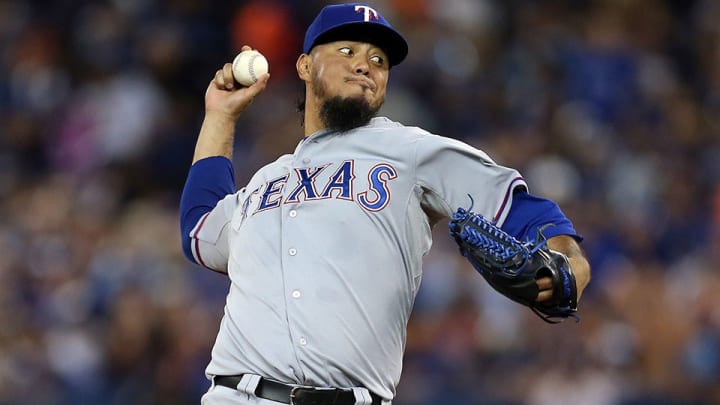Orioles get Gallardo, but loss of Fowler, draft pick stings

They took their sweet time about it, but the Orioles’ long-delayed contract with righthander Yovani Gallardo was finally made official Thursday morning as a two-year, $22 million deal with a $13 million club option for 2018. With a $2 million buyout on the option, the maximum value of the contract (not counting the long-shot awards bonuses) is three years and $33 million.
The addition of Gallardo, however, comes with the news that Baltimore’s accompanying signing of outfielder Dexter Fowler—reported to be exactly three years at $33 million—has fallen through, as Fowler has returned to the Cubs on a one-year deal with a mutual option for 2017 for $13 million guaranteed. The failure to secure Fowler (the details of which are still coming to light) significantly undermines the signing of Gallardo. With both players declining qualifying offers from their previous teams, Baltimore has now sacrificed the No. 14 pick in this June’s draft for only half of the return they thought they were getting.
In a study I did of the top 33 picks in the draft between 1990 and 2010, I found that there was a clear dividing line between the top 13 picks and those that came after in terms of the cumulative Wins Above Replacement to come out of each slot. The No. 14 pick, however, yielded Jason Heyward to the Braves in 2007 and Jose Fernandez to the Marlins in '11; both of those players rank among the best ever selected at that spot. Were I to update of that study (done prior to the 2013 draft), then, it is very likely that I would move that line to after the 14th pick.
Spring training preview: American League East
That No. 14 pick is a lot to give up for Gallardo, a 30-year-old pitcher whose contract was briefly held up due to concerns over his physical, even if the Orioles did manage to restructure his contract from the original guarantee of three years and $35 million and to defer some of his salary. The shoulder issues that led to the renegotiating of the contract are not an area of preexisting concern, as Gallardo has made at least 30 starts and thrown at least 180 innings in each of the last seven seasons and has never hit the disabled list due to an arm injury. They are not a total surprise, however, given the decline in Gallardo’s velocity and, more dramatically, his strikeout rates over the last several seasons. Gallardo’s average fastball was two miles per hour slower in 2015 than it was in '11, but that gradual decline appears to have leveled off; his velocity last year was a close match for his average in '13. His strikeout rates have been in free fall over the last few years, however. Consider this chart of Gallardo’s annual strikeout percentage (black) against the major league average (grey) since 2009:
Accompanying Gallardo’s decline in strikeouts has been an increase in his use of his sinker, a pitch he started throwing in 2011 and threw more than 21% of the time last year—a career high, according to BrooksBaseball.net. That increased use of his sinker has been accompanied by an increased ground-ball rate, turning a pitcher who struck out 200 or more men four years in a row (from 2009 to '12) into a pitch-to-contact ground-baller.
This version of Gallardo had surprising success with the Rangers last year: He posted career-best 124 ERA+ in 2015, including a strong 3.52 ERA in 16 starts at Texas’ launching pad of a home stadium. It is also a particularly good fit for the Orioles, who have not only a homer-happy ballpark, but also outstanding infield defense. Third baseman Manny Machado and shortstop J.J. Hardy are elite defenders on the left side of the infield, and second baseman Jonathan Schoop and first baseman Davis are both capable of being above average on the right side. What's more, Baltimore as an organization has embraced the shift, with only the Rays, Astros, Rockies, Pirates and Yankees shifting more than the O's in 2015.
All of that bodes well for Gallardo, who would seem to stand a decent chance of repeating his 2015 success with the Orioles, and his addition gives Baltimore a suitable replacement for departed free agent Wei-Yin Chen, who also rejected a qualifying offer and netted Baltimore a compensation pick when he signed with the Marlins. But there is a big difference between the 14th selection and the 28th, the latter of which will now be the Orioles’ top pick in June. Only three No. 28 picks in draft history have surpassed 11.4 Wins Above Replacement (baseball-reference.com version); a dozen No. 14 picks have done so, with Fernandez likely to join that group as soon as this year. With Fowler in rightfield and Gallardo in the rotation, you could justify sacrificing that pick. Gallardo alone, however, does not change the Orioles' outlook enough to make the move worth it.

Cliff Corcoran is a contributing writer for SI.com. He has also edited or contributed chapters to 13 books about baseball, including seven Baseball Prospectus annuals.